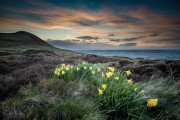Step back in time to Fife’s prehistoric past and discover these fascinating ancient places. It's time to go on a dinosaur hunt.
1. Balbirnie Stone Circle
Known locally as The Druid’s Circle, eight stones with mysterious markings stand guard in the woods near Balbirnie Hotel. However, although believed to date back to 3000 BC, Balbirnie Stone Circle has only been in this site since 1970. The standing stones were relocated when the nearby main road was widened – they previously stood on the other side of the A92, where they marked a Bronze Age burial site.
2. Balfarg Henge
Balfarg Henge - a sacred site dating back to 4,000 BC - is the focal point of Balfarg housing estate in Glenrothes. Although two impressive standing stones and the flat Central Stone are all that remain of a large circle of standing stones surrounded by a deep ditch, Belfarg Henge is prehistoric proof that Scotland’s newest town, Glenrothes, has been a popular place to live for over 6,000 years!
3. Boarhills’ Dinosaurs!
Long, long, long ago, giant millipedes roamed through the dense tropical forests that covered Fife! And, 310 million years later, their footprints can be still be seen! Arthropleura, as these gigantic, prehistoric woodlice (or slaters) are officially known, left a trail of 20 cm-wide tracks on an outcrop of sandstone near Boarhills, alongside a mini-forest of fossilised, prehistoric tree roots.
4. Crail’s Prehistoric Creatures
Fife’s ‘dinosaur slaters’ certainly made their mark as Arthropleura tracks can also be seen in the cliffs and on the foreshore at Crail, just beside the harbour. There’s also a giant fossilised tree stump in the rock pools at the foot of the cliffs, while the bays around Crail have lots to offer to eagle-eyed fossil hunters!
5. Dunino Den’s Unknown Past
Dunino Den is a place of mystery, legend and, some would have it, magic. It may have been a Druid ceremonial site, it may have been where kings were crowned, it may be haunted by lost spirits – no-one knows the truth about Dunino Den. However, with enigmatic carvings etched into the ancient steps that lead down into the Den, an altar stone with a footprint carved into it and tokens left for the fairies, this is definitely a place where people have worshipped since time began.
6. East Wemyss’ Ancient Artists
The Picts who lived on the stretch of coast near the village of East Wemyss were the first of the many artists who have made this part of Scotland their home. The walls of the world-famous Wemyss Caves are adorned with carvings made by Picts between 300 and 3400 AD, which are Scotland’s oldest and largest collection of Pictish symbols. To visit the caves, contact The Save Wemyss Ancient Caves Society (wemysscaves.org), which offers free guided tours.
7. Kingsbarns Beach – Fossils, Fossils, everywhere!
There’s much more than crabs, shells, sea anemones and starfish to be found in the rock pools at Kingsbarns Beach. This stretch of the Fife coast is renowned for its abundance of fossils. When the tide is out, the remains of a fossilised forest – and other 310 million-year-old plants - can be seen, embedded into the slabs of sandstone on the foreshore.
8. Lundin Links’ Ancient History
There can’t be many golf courses where golfers have to avoid hitting a standing stone – or three! The second fairway of Lundin Links’ Ladies 9-hole golf course is dominated by three giant standing stones dating back to 2000 BC.
As further evidence of Lundin Links’ prehistoric significance, in 1965, a storm uncovered a Pictish cemetery on Massney Braes, overlooking Lundin Links Beach. Archaeological excavations revealed that several of those buried there had been given elaborate send-offs so perhaps were important in the Pictish Kingdom of Fib, later known as the Kingdom of Fife.
9. Stone Age Burntisland
Take a good look at the rocks as you climb Binn Hill, the extinct volcano that towers over Burntisland. Many thousands of years ago, the boulders of Binn Hill were decorated by the local residents, who left a variety of ring patterns and cup marks to be wondered at by today’s historians and archaeologists. The carvings are thought to date back to the last days of the Stone Age – so are very, very, very old indeed!
10. Tuilyies Standing Stones
The Tuilyies Standing Stones is a sacred Bronze age site featuring an impressive standing stone with cup marks and vertical grooves, which may be the result of carving or weathering, and three large boulders. Situated in a field between Rosyth and Kincardine, legend has it that the Tuilyies Standing Stones mark the graves of four chieftains who died in battle around 2,000 BC – a legend which is given further credence by ‘tulzie’ being the Old Scots word for a battle.





